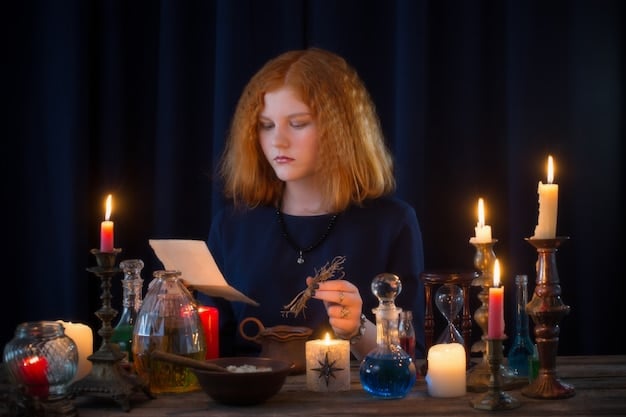Creating a Sacred Space: A Guide to Witchcraft Practices

Creating a sacred space involves cleansing, consecrating, and maintaining an area specifically for your witchcraft practice. This dedicated space enhances focus, provides a connection to the divine, and empowers your magical workings.
Embarking on a witchcraft practice often begins with creating a sacred space. This isn’t just about tidying up a corner; it’s about establishing a dedicated area where you can connect with the divine, focus your energy, and perform your rituals. This guide will walk you through the steps of cleansing, consecrating, and maintaining your sacred space.
Understanding the Importance of a Sacred Space
Before diving into the how-to, it’s crucial to understand why creating a sacred space is so important in witchcraft. A sacred space serves as a focal point for your energy, a place where the veil between worlds is thinner, and a sanctuary where you can connect with your deities or the universe.
Enhanced Focus and Intention
A dedicated space helps to clear your mind and focus your intentions. When you step into your sacred space, you’re signaling to your subconscious that it’s time to engage in magical work, leaving behind the distractions of the mundane world.
Connection to the Divine
Your sacred space can become a conduit for connecting with deities, spirits, or the universal energy. By consistently using the space for rituals and practices, you imbue it with your energy and create a stronger link to the spiritual realm.
Empowered Magical Workings
A well-maintained and energetically charged sacred space can significantly amplify the power of your spells and rituals. The focused energy and clear intentions within the space create a fertile ground for manifestation.

In essence, creating a sacred space is more than just arranging objects; it’s about creating a potent and transformative environment for your witchcraft practice. By understanding its importance, you can approach the process with the reverence and intention it deserves.
Cleansing Your Space: Preparing for Consecration
The first step in creating a sacred space is cleansing it of any unwanted or stagnant energy. This process removes any lingering negativity and prepares the area for consecration.
Physical Cleansing
Begin with a thorough physical cleaning. Dust, sweep, and tidy up the area. A clean space reflects a clear mind and allows for a better flow of energy.
Energetic Cleansing
Once the space is physically clean, you can move on to energetic cleansing. There are many methods you can use, including:
- Smudging: Burning herbs like sage, palo santo, or lavender and allowing the smoke to fill the space. Focus your intention on clearing out negative energies.
- Salt: Sprinkle salt in the corners of the room or the perimeter of your space. Salt is a powerful absorber of negative energy. You can sweep it up after a few hours.
- Sound: Using bells, singing bowls, or your own voice to create vibrations that disrupt and clear stagnant energy. Focus on positive affirmations or intentions as you create the sound.
- Visualization: Visualize a bright, white light filling the space, dissolving any negativity and replacing it with positive energy.
Choose the method that resonates most with you. As you cleanse, visualize any unwanted energy leaving the space, replaced with a sense of peace and tranquility. Cleansing is the important first step in creating a sacred space.
Consecrating Your Sacred Space: Imbue it with Purpose
After cleansing, the next step is to consecrate the space, dedicating it to your specific purpose and imbuing it with your energy and intention. This process transforms a regular space into a powerful sanctuary for your practice—an essential step in creating a sacred space.
Defining Your Purpose
Before you begin, take some time to define the purpose of your sacred space. What will you be using it for? Meditation? Spellwork? Connecting with deities? Knowing your intention will guide the consecration process.
Calling Upon the Elements
A common method of consecration involves calling upon the four elements: Earth, Air, Fire, and Water. Each element represents a different aspect of the universe and can bring its unique energy to your sacred space. Here’s how you might do it:
- Earth: Place a bowl of salt or a stone in the north of your space. Say something like, “I call upon the element of Earth, grounding and stability, to bless and protect this space.”
- Air: Light incense or diffuse essential oils in the east. Say, “I call upon the element of Air, communication and wisdom, to inspire and guide my work within this space.”
- Fire: Light a candle in the south. Say, “I call upon the element of Fire, passion and transformation, to ignite my intention and empower my spells within this space.”
- Water: Place a bowl of water or a chalice in the west. Say, “I call upon the element of Water, emotion and intuition, to nourish and cleanse my spirit within this space.”
Personal Touches
In addition to the elements, you can add personal touches to your consecration. This might include:
- Placing meaningful objects on your altar, such as crystals, tarot cards, or representations of your deities.
- Reciting a prayer or incantation that resonates with you.
- Visualizing your desired energy filling the space, creating a protective and powerful aura.

Remember, the consecration process is deeply personal. Adapt these suggestions to fit your beliefs and practices. The most important thing is to approach it with intention and reverence, carefully creating a sacred space that resonates with your soul.
Setting Up Your Altar: A Focal Point of Energy
Your altar serves as the central point of energy within your sacred space. It’s where you place the tools and objects you use in your practice, and it acts as a visual representation of your connection to the divine. It should be setup mindfully when creating a sacred space.
Choosing Your Space
Select a surface that feels right to you. This could be a small table, a shelf, or even a dedicated space on the floor. Consider the size of the space you have available and the tools you plan to use.
Essential Tools and Objects
The tools and objects you place on your altar are highly personal and will vary depending on your path and preferences. Some common items include:
- Candles: Used for focusing energy and representing different elements or deities.
- Crystals: Each crystal has unique properties that can enhance your magical work.
- Tarot Cards: Used for divination and gaining insight into situations or questions.
- Incense: Used for cleansing and raising energy.
- Chalice: Represents the element of Water and the divine feminine.
- Wand: Used for directing energy.
- Athame: A ritual knife used for directing energy (never used for physical cutting).
- Representations of Deities: Statues, images, or symbols of the deities you work with.
Arranging with Intention
Arrange your altar in a way that feels balanced and aesthetically pleasing to you. Consider the symbolism of each object and its placement. Some practitioners arrange their altar according to the elements, with Earth in the north, Air in the east, Fire in the south, and Water in the west. An intentional arrangement is key when creating a sacred space.
Remember, your altar is a reflection of your personal practice. There’s no right or wrong way to set it up. Trust your intuition and create a space that resonates with your soul.
Maintaining Your Sacred Space: Keeping the Energy Flowing
Creating a sacred space is just the beginning. Maintaining its energy and keeping it clear is crucial for ensuring that it remains a powerful and effective tool for your practice. Maintenance is an ongoing process that involves both physical and energetic upkeep.
Regular Cleansing
Continue to cleanse your space regularly, even if it doesn’t feel like it needs it. A quick smudging or visualization can help to keep the energy fresh and flowing. A good practice is to cleanse your space after any particularly intense or challenging magical work.
Tidying and Organizing
Keep your altar and the surrounding area tidy and organized. Clutter can impede the flow of energy and make it difficult to focus. Take a few minutes each day or week to tidy up and rearrange your altar as needed.
Recharging Objects
Periodically recharge the objects on your altar. This can be done by placing them in sunlight or moonlight, burying them in the earth, or holding them in your hands and visualizing them being filled with energy.
Setting Boundaries
Protect your sacred space from unwanted energies by setting clear boundaries. This might involve visualizing a protective shield around the space or stating your intention that only positive and beneficial energies are allowed to enter. Setting the boundaries is an important part of creating a sacred space.
Adapting Your Space to Your Needs
Your sacred space should evolve along with your practice. As you grow and change, your needs may shift, and your space should reflect that. Periodically re-evaluate your altar and the overall layout of your space to ensure that it continues to support your magical work. Creating a sacred space means adapting to your needs.
Experimenting with Different Layouts
Don’t be afraid to experiment with different layouts for your altar and your space. Try arranging your tools and objects in different ways to see what feels most comfortable and effective for you. You might find that a different arrangement enhances your focus or opens up new channels of energy.
Incorporating New Tools and Objects
As you learn more about witchcraft and discover new tools and objects that resonate with you, incorporate them into your sacred space. This could include new crystals, herbs, tarot cards, or representations of deities.
Adjusting to Different Environments
If you move or your living situation changes, you may need to adapt your sacred space to a new environment. This might involve creating a smaller, more portable altar or finding creative ways to delineate your sacred space within a shared living area.
Remember, your sacred space is a dynamic and evolving reflection of your personal practice. Embrace the process of adapting and refining it to meet your changing needs. The most important thing is that it remains a place where you feel connected to the divine and empowered to pursue your magical goals with creating a sacred space.
| Key Point | Brief Description |
|---|---|
| 🧹 Cleansing | Removing negative energy with methods like smudging or salt. |
| ✨ Consecration | Dedicating the space to a specific purpose with intention. |
| Altar Setup | Arranging tools (candles, crystals) with intention for energy focus. |
| 🔄 Maintenance | Regularly cleansing and tidying to keep energy flowing. |
Frequently Asked Questions
It provides a dedicated area for focused energy, a stronger connection to the divine, and amplifies the power of your magical workings.
Ideally, cleanse it regularly, even if it feels clean. After any intense or challenging magical work, cleansing is essential to clear lingering energies.
Calling upon the four elements (Earth, Air, Fire, Water) and adding personal touches like meaningful objects and prayers are common.
You can create a small, portable altar or dedicate a corner of a room. The intention is more important than the size of the space.
Regular cleansing, tidying, recharging objects, and setting clear boundaries are key to maintaining a powerful and effective sacred space.
Conclusion
Creating a sacred space is a deeply personal and transformative process that forms the foundation of your witchcraft practice. By cleansing, consecrating, and maintaining your space with intention and reverence, you create a powerful sanctuary where you can connect with the divine, focus your energy, and manifest your desires.
Remember to adapt your space to your evolving needs and trust your intuition as you create a space that resonates with your soul. With dedication and care, your sacred space will become a powerful tool for your magical journey





